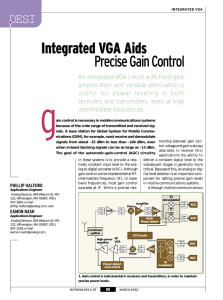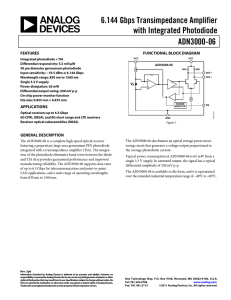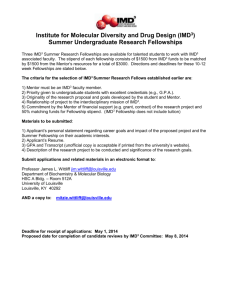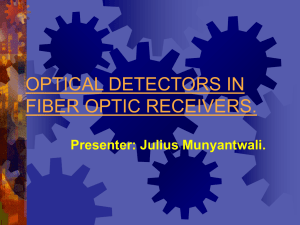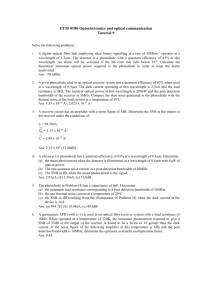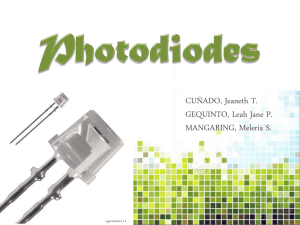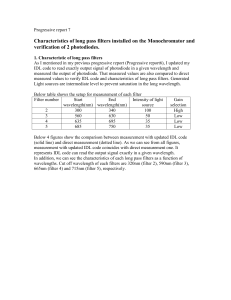Experimental analysis of two measurement techniques to characterize photodiode linearity Please share
advertisement
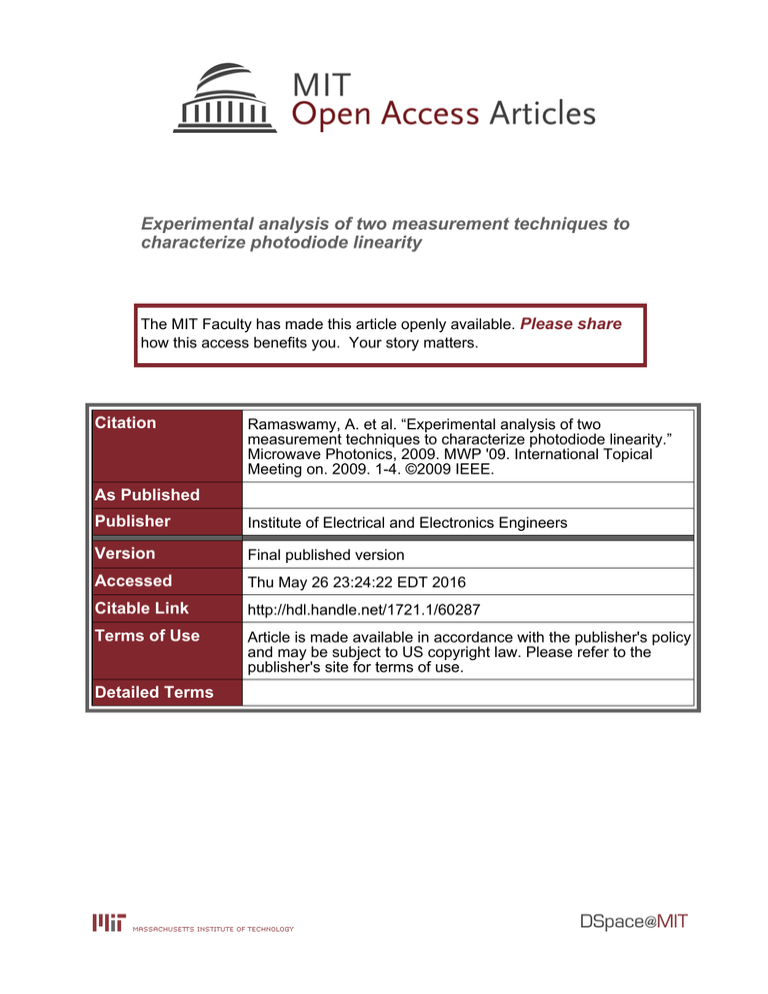
Experimental analysis of two measurement techniques to
characterize photodiode linearity
The MIT Faculty has made this article openly available. Please share
how this access benefits you. Your story matters.
Citation
Ramaswamy, A. et al. “Experimental analysis of two
measurement techniques to characterize photodiode linearity.”
Microwave Photonics, 2009. MWP '09. International Topical
Meeting on. 2009. 1-4. ©2009 IEEE.
As Published
Publisher
Institute of Electrical and Electronics Engineers
Version
Final published version
Accessed
Thu May 26 23:24:22 EDT 2016
Citable Link
http://hdl.handle.net/1721.1/60287
Terms of Use
Article is made available in accordance with the publisher's policy
and may be subject to US copyright law. Please refer to the
publisher's site for terms of use.
Detailed Terms
Experimental Analysis of Two Measurement
Techniques to Characterize Photodiode Linearity
Anand Ramaswamy, Nobuhiro Nunoya, Molly Piels, Leif A. Johansson, Larry A. Coldren and John E. Bowers
Electrical & Computer Engineering Department, University of California, Santa Barbara, CA 93106, USA
Alexander S. Hastings and Keith J. Williams
Naval Research Laboratory, Code 5650, Washington, D.C. 20375, USA
Jonathan Klamkin
Lincoln Laboratory, Massachusetts Institute of Technology, 244 Wood St, Lexington, M.A. 02420, USA
anand@ece.ucsb.edu
Abstract—As photodiodes become more linear, accurately
characterizing their linearity becomes very challenging. We
compare the IMD3 results from a standard two tone
measurement to those from a more complex three tone
measurement technique. A Ge n-i-p waveguide photodetector
on Silicon-on-Insulator (SOI) substrate is used for the
comparison. Additionally, we analyze, via simulation, the
limitations of the measurement system in determining the
distortion of highly linear photodiodes.
I.
INTRODUCTION
High performance analog optical links require photodiodes
that have high power handling capability as well as high
linearity [1]. Surface illuminated photodiodes with over
700mA of photocurrent [2] and 3rd order Output Intercept
Points (OIP3) in excess of 50dBm have been reported [3].
UTC based waveguide detectors with OIP3’s >40dBm have
also been reported [4]. Improvements in photodiode linearity
create significant measurement challenges. Namely, distortion
from the measurement system influences and in some cases
limits the measured third order intermodulation distortion
(IMD3). Currently, various techniques are used to determine
the IMD3 of photodiodes [3, 5, 6]. When two closely spaced
pure radio frequency (RF) tones are incident on the device, the
resulting IMD3 measured should emanate entirely from the
distortion of the photodiode. One way to get a pure RF tone
with 100% modulation depth is through a two-laser
heterodyne system [7]. However, generating a second tone
that is close in frequency to the first tone would require an
additional pair of lasers. Moreover, all four lasers need to be
closely matched in wavelength and immune to thermal and
other drifts. The latter requirement necessitates the lasers in
each pair be locked to each other, further complicating the
measurement setup.
An alternative to optical heterodyning is using external
intensity modulators to generate two RF tones by modulating
the output of two c.w. lasers. Although this greatly simplifies
the measurement setup, it introduces nonlinearities into the
measurement through the intensity modulators and RF signal
generators. An alternate approach to the two tone
measurement technique is to use three tones to measure IMD3
[6, 8]. In this technique, some of the third order non linear
distortion components generated in the device under test
(DUT) are independent of the harmonics originating in the
optical modulators and signal generators.
In this work, we take a Ge n-i-p waveguide photodetector
on SOI [9] and use both the above modulator techniques to
measure its IMD3. It is observed that the two approaches yield
OIP3 results that are consistent with each other. Next, we
show mathematically that as the OIP3 of a photodiode
increases the results from the two techniques diverge. We find
that the two-tone technique is sensitive to non-linearities in the
optical source whereas the same is not true of the three-tone
technique. This establishes the three-tone measurement
technique as the preferred technique for measuring very linear
photodiodes.
Figure 1. Experimental setup: three-tone measurement
II.
EXPERIMENT
Figure 1 shows a schematic of the three tone experimental
setup. The output of three CW lasers with differing
EXPERIMENTAL RESULTS
III.
The device used for this experiment is a 7.4μm X 500μm
evanescently coupled Ge waveguide photodetector that is
grown on top of a Si rib waveguide. The 3dB bandwidth of
the device is ~4.5GHz. Details of the device design and
fabrication can be found in [9].
40
20
0
Fundamental
-20
IMD3(3tone)
-60
-80
IMD3(2tone)
-100
-120
-10
0
10
20
Input (dB)
Fundamental
Signal (f1, f2, f3)
0.998 GHz
1 GHz
1.0015 GHz
1.998 GHz
1.9995 GHz
2.0015 GHz
0.996 GHz
0.9945 GHz
0.9965 GHz
1.0035 GHz
-40
30
40
IMD2
IMD3 (two tone)
IMD3 (three tone)
50
Figure 3. Sample experimental plot from a three-tone measurement
(photocurrent =20mA; bias voltage across photodiode=2V)
20
f1
0
f2
f3
-20
Intensity (dBm)
three tone IMD3’s differ by a factor of 2 (or 6dB in Electrical
Power). The three-tone IP3 is 3dB smaller than the two-tone
IP3 [6]. Hence, a factor of 3dB is added to the three-tone IP3
to relate this to the more commonly used two-tone IP3.
Output Power (dBm)
wavelengths (Δλ ~0.5-7nm) are modulated separately at
frequencies f1=980MHz, f2=1GHz and f3=1.015GHz. The
modulators are biased at quadrature to minimize second
harmonics. The three optical signals carrying RF modulation
are combined and amplified by an Erbium Doped Fiber
Amplifier
(EDFA).
Experimentally
second
orderintermodulation distortion has been observed due to the
coupling of the gain tilt of an EDFA with frequency chirp of
the modulated input signal [10]. However, in this experiment
we use x-cut y propagating LiNbO3 modulators whose chirp
parameters are experimentally determined to be ~0.1[11]-a
factor of 10 less than that of directly modulated
semiconductor lasers [12]. Hence, the EDFA induced
distortion can be assumed to be negligible. An attenuator is
used at the output of the EDFA to control the modulation
index of the three tones. A fourth CW laser is used to ensure
that the optical power and hence, photocurrent in the device
remains unchanged as the optical modulation index is varied.
For this experiment the optical modulation index is varied
between approximately 20-30%. The third order
intermodulation distortion components are measured at
frequencies (f1+f2) – f3, (f1+f3) – f2 and (f2+f3) –f1as shown in
Figure 2. It is important to note that in a three tone linearity
measurement such as this, IMD3 from the interaction of two
tones is also generated. In other words, in theory, distortion
components can be observed at 2fi –fk (i,k={1,2,3} ; i≠k).
f1+f2-f3
-f1+f2+f3
-40
2f1-f2
-60
2f1-f3
f1-f2+f3
2f2-f3
-80
-100
2f3-f2
2f2-f1
2f3-f1
6dB
-120
940
960
980
1000
1020
Frequency (MHz)
1040
1060
Figure 2. Ilustration of IMD3 components in a three-tone experiment
As outlined in [6] the three-tone IMD3 is 6dB larger than the
ideally measured two-tone IMD3. This can be inferred from
the expressions below:
Figure 3 plots the output RF power (in dBm) in the
fundamental signals, third order distortion components (both
two-tone and three-tone) and second order intermodulation
distortion components (IMD2) versus the change in input RF
power (dB) into the device. As mentioned in the previous
section, the change in input RF power essentially corresponds
to a change in optical modulation index, which is
experimentally determined to be between 20-30%. Note that
for the first time, both the two-tone and three-tone
characterization of a photodiode's IMD3 are simultaneously
measured. This provides for an accurate comparison of the
measurement techniques since the various experimental
conditions (e.g. optical modulation index, input RF power
etc.) in the measurement system remain relatively constant
during the course of the measurement.
60
3
IMD3(2fi –fk):
IMD3(fi–(fj+fk):
3h3 § m ·
¨ ¸
4 ¨© h1 ¸¹
(1)
40
3
6h3 § m ·
¨ ¸
4 ¨© h1 ¸¹
50
(2)
3
OIP2, OIP3 (dBm)
Fundamental (fi):
15h3 § m ·
¨ ¸ |m
m
4 ¨© h1 ¸¹
30
20.59
20
18.63
10
(3)
As the power in the fundamental tone (1) goes up by 1 dB,
the power in both the two-tone (2) and three-tone IMD3
components (3) go up by 3dB. Note that the two-tone and
17.05
16.02
6.55
3.17
0
-10
19.19
18.37
0
1
2
OIP2
OIP3(2tone)
OIP3(3tone)
3
4
5
6
Voltage (V)
7
8
9
10
Figure 4. OIP2, OIP3 as a function of reverse bias (photocurrent=20mA)
IV.
NON-LINEARITIES OF MEASUREMENT
SYSTEM
In this section we study the effect on OIP3 due to
distortion in the optical source carrying the modulated RF
tones. A model is developed for the three tone experimental
setup shown in Figure 1. If the input signal from the signal
generator to the modulator is given as VRF=Vo(sinωt) and we
assume a Taylor series expansion for the phase shift in the
modulator we get:
(
=
+
1
2
2
+
3
3
+ ⋯)
Next, we introduce distortion in the optical source as follows:
c2/ c1=-0.01 and c3/ c1=-0.001. Figure 6 plots the OIP3 for
both the two-tone and three-tone case as the second order non
linear coefficient (a2) in the photodiode is varied, while
keeping a3 fixed. It can be seen that depending on the
magnitude and sign of a2 of the photodiode the calculated twotone OIP3 can be either be ~6dB greater or ~3dB less than its
actual value. Further, the three-tone OIP3 remains constant
even as a2 is varied. In Figure 7 the third order non-linear
coefficient (a3) in the photodiode is varied while keeping a2
fixed. Again it can be clearly seen that the two-tone and threetone OIP3 deviate from their 3dB difference as given by
equations (2) and (3).
50
OIP3(2f1-f2)
OIP3(f1+f2-f3)
OIP3(f1+f2-f3)+3dB
45
(4)
40
where Vπ is assumed to be 5.0V. Additionally, when the
modulators are biased at quadrature, the output power (Pout) is
related to the input power as follows:
=
2
)
(1 −
35
(5)
2
2
+
3
3
+⋯
(6)
Figure 5 plots the IMD3 and IMD2 calculated using this
model. The modulator is assumed to be linear (c2=0 and c3=0)
and the non-linear coefficients assumed in the detector are
indicated in Figure 6. From this calculation, the two-tone and
three -tone OIP3 are found to be 42.218dBm and 39.208dBm.
Since, these OIP3 values are similar to experimentally
observed values [4] the range of relative non-linear
coefficients of the photodiode used in this calculation (and
subsequent calculations) can be assumed to be reasonably
close to the devices in [4].
60
40
20
Fundamental: f1
IMD3(2tone): 2f1-f2
IMD3(3tone): f1+f2-f3
IMD2: f1+f2
Output Power (dBm)
0
-20
-40
-60
-80
-100
a1= 1
a2/a1 = -1
a3/a1 = -2
6dB
-120
-140
-20
-10
0
10
20
Input Power (dBm)
30
40
50
Figure 5. Calculated IMD3 and IMD2 (Pdc= 40mW)
52
-1.5
-1
-0.5
0
0.5
a2 of Photodiode
OIP3(2f1-f2)
OIP3(f1+f2-f3)
OIP3(f1+f2-f3)+3dB
50
1
1.5
2
a2/a1 = -1
48
46
OIP3 (dBm)
+
1
-2
Figure 6. OIP3 dependence on a2 of photodiode
Similarly, for the photodiode under test, the input optical
power has two components: PDC and PRF and correspondingly,
the output photocurrent has two components – a DC one given
by IDC= a1PDC and an RF one given by:
=
a3/a1 = -2
OIP3 (dBm)
Figure 4 summarizes the experimental OIP3 and OIP2 results
as a function of reverse bias at a photocurrent of 20mA.
Although the difference between the two-tone OIP3 and
three-tone OIP3 is not quite the theoretical 3dB, it clearly
follows the theoretical trend. This is important because in
Section IV it will be shown via simulation that when the
linearity of the device is very high (and the distortion of the
measurement system begins to dominate), the two tone and
three tone techniques yield very different OIP3 values.
44
42
40
38
36
34
-6
Figure 7.
-4
-2
0
2
a3 of Photodiode
4
6
OIP3 dependence on a3 of photodiode
The deviation of the two-tone OIP3 from the actual OIP3
value is a result of the interaction between the non-linear
coefficients of the optical source (c2 and c3) and the 2nd order
non linear coefficient of the photodiode (a2). To confirm this,
in Figure 8, a2/ a1 =-1 is fixed and the OIP3 (both two-tone
and three-tone) is plotted as a function of a3 while keeping the
optical source perfectly linear (c2, c3=0). Furthermore, in
Figure 9 we reintroduce the earlier distortion in the optical
source, but set a2=0, thereby eliminating any interaction
between the photodiode 2nd order non-linearity and the
modulator. In both cases, it can be observed that the two-tone
and three-tone results maintain the 3 dB difference as expected
from (2) and (3).
52
OIP3(2f1-f2)
OIP3(f1+f2-f3)
OIP3(f1+f2-f3)+3dB
50
a1= 1.0 [A/W]
a2/a1 = -1
48
OIP3 (dBm)
46
44
42
40
38
36
34
-6
-4
-2
0
2
a3 of Photodiode
4
6
Figure 8. OIP3 dependence on a3 of photodiode with perfectly linear
optical source (c2, c3=0)
52
OIP3(2f1-f2)
OIP3(f1+f2-f3)
OIP3(f1+f2-f3)+3dB
50
48
a1= 1.0 [A/W]
a2/a1 = 0
OIP3 (dBm)
46
44
42
40
2-3dB, which is close to the 3dB predicted theoretically.
Additionally, to show the need to adopt the more complex but
more accurate three-tone measurement technique, we have
modeled the measurement setup, introducing nonlinearities
from both the optical modulator and RF signal generator. We
find that the 2nd and 3rd order non-linear components (c2, c3) of
the optical modulators affect the two-tone OIP3 measured in
the detector because they interact with the photodiode nonlinear coefficients (a2 and a3). On the other hand, the threetone OIP3 remains unaffected by distortion in the optical
source. Thus, as the linearity of photodiodes continues to
increase, it is necessary to use a measurement technique such
as the three-tone system to accurately characterize photodiode
nonlinearities.
ACKNOWLEDGMENT
The authors would like to thank useful discussions with
Ronald Esman, Steve Pappert, Jim Hunter and Nadir Dagli.
Further acknowledgement should be provided to Tao Yin
from Intel Corp. for providing the SiGe detector on which
these measurements were made. This material is based upon
work supported by the DARPA-PHORFRONT program
under United States Air Force contract number FA8750-05C-0265.
REFERENCES
38
[1]
36
34
-6
-4
-2
0
2
a3 of Photodiode
4
6
Figure 9. OIP3 dependence on a3 of photodiode with a2/ a1 =0 but not a
perfectly linear optical source (c2/ c1 = -0.01 and c3/ c1 = -0.001)
However, in reality there will be some second-order
distortion coming from the optical source either due to a poor
driver amplifier or improper biasing. Even if the intensity
modulators are made out of a highly linear material (e.g.
LiNbO3), as in the case of this experiment, and the
modulators are biased at quadrature (to minimize c2), there
will still be some residual second-order distortion due to
thermal drift of the bias point. Additionally, having a2=0 in
the photodiode is not possible, so the two-tone measurement
system will always add a certain nonlinearity (or at least an
uncertainty) to the measurement. Thus the three-tone
measurement system should be used to eliminate possible
errors coming from nonzero a2, c2 and c3. This is particularly
true as the linearity of detectors approach numbers in excess
of 40dBm.
V.
CONCLUSION
In this paper we have performed a detailed experimental
characterization of two different linearity measurement
techniques on the same photodiode for the first time. Using a
Ge n-i-p waveguide photodetector on a Silicon-on-Insulator
(SOI) substrate we have simultaneously measured both the
three- tone OIP3 and the two-tone OIP3. Comparing these
results, we find that at a photocurrent of 20mA, the difference
between the two-tone and three -tone OIP3 is approximately
K. J. Williams and R. D. Esman, "Design Considerations for HighCurrent Photodetectors," J. Lightw. Technol., Vol. 17, no. 8, pp. 1443 1454, Aug. 1999.
[2] D. A. Tulchinsky et al., “High Current Photodetectors as Efficient,
Linear and High-Power RF Ouput Stages,” J. Lightw. Technol., Vol.
26, no. 4, pp. 408 - 416, Feb. 2008.
[3] A. Beling, H. Pan, H. Chen and J. C. Campbell, “Measurement and
Modeling of a High-Linearity Modified Uni-Traveling Carrier
Photodiode,” IEEE Photon. Technol. Lett., Vol. 20, no. 14. pp 1219 1221, Jul. 2008.
[4] J. Klamkin et al., “Uni-Traveling-Carrier Waveguide Photodiodes with
>40 dBm OIP3 for up to 80 mA of Photocurrent,” Device Research
Conference (DRC), Late News, Jun. 2008.
[5] A. Joshi, S. Datta and D. Becker, “GRIN Lens Coupled Top
Illuminated Highly Linear InGaAs Photodiodes,” IEEE Photon.
Technol. Lett., Vol. 20, no. 17. pp 1500 - 1502, Sep. 2008.
[6] T. Ohno et al. “Measurement of Intermodulation Distortion in a
Unitraveling-Carrier Refracting-Facet Photodiode and a p-i-n
Refracting-Facet Photodiode,” IEEE Photon. Technol. Lett., Vol. 14,
no. 3. pp 375 - 377, Mar. 2008.
[7] R.D. Esman and K. J. Williams “Measurement of Harmonic Distortion
in Microwave Photodetectors,” IEEE Photon. Technol. Lett., Vol. 2, no.
7. pp 502 - 504, Jul. 1990.
[8] T. Ozeki and E. Hara, “ Measurement of nonlinear distortion in
photodiodes,” Elec. Lett., Vol. 12, pp. 80-81, 1976.
[9] T. Yin, et al., “31 GHz Ge n-i-p waveguide photodetectors on Siliconon-Insulator substrate,” Opt. Exp., Vol. 15, Issue 21, pp. 13965-13971,
Oct. 2007.
[10] K. Kikushima and H. Yoshinaga, “Distortion Due to Gain Tilt of
Erbium-Doped Fiber Amplifiers,” IEEE Photon. Technol. Lett., Vol. 3,
no. 10. pp 945 - 947, Oct. 1991.
[11] N. Courjal and J.M. Dudley, “Extinction-ratio-independent method for
chirp measurements of Mach-Zender modulators”, Opt Exp., Vol. 12,
Issue 3, pp. 442–448, Feb. 2004.
[12] F. Koyama and K. Iga, “Frequency Chirping in External Modulators,”
J. Lightw. Technol., Vol. 6, no. 1, pp. 87-93, Jan 1988.
